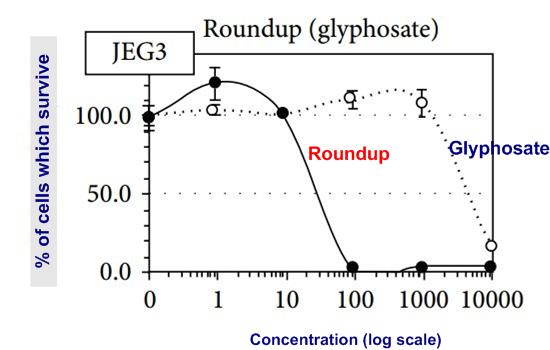Off topic – Roundup found to be 125X more toxic than its active ingredient (glyphosate)
Roundup Herbicide 125 Times More Toxic Than Regulators Say GreenMedInfo, April 2014
Based on study Major pesticides are more toxic to human cells than their declared active principles , published in the journal Biomedical Research International, which is attached at the bottom of this page.
Study looked at 9 major pesticides:
3 herbicides,
3 insecticides, and
3 fungicides.
Found that in EVERY CASE, the ‘’inactive’’ ingredients made the pesticide far more toxic to humans than its ‘’active’’ ingredients
The graphs of human cell survival for Roundup and Glyphosate

These are placental cells exposed for <24 hours. Researches noted that the toxicity is worse for longer time periods.
Key findings included:
- On human cells, among the tested products, fungicides were the most toxicbeing cytotoxic from doses 300–600 times lower than agricultural dilutions,
- followed by herbicides (except Matin)
- and then insecticides.
In all cell types, fungicides were the most toxic (mean LC50 12ppm).
The herbicide Roundup (LC50 63ppm) was next in toxicity to fungicides,
- twice as toxic as Starane, and
- more than 10 times as toxic as the 3 insecticides, which represent the less toxic group (mean LC50 720ppm).
So, what about Roundup and Vitamin D
Roundup most likely stresses human cells
Vitamin D helps the body deal with stresses.
10 most-visited pages in Glysophate category in Vitamin D Life
{LISTPAGES}
See also web
- GMO crops totally banned in Russia... Sept 2015
- "share of GMO in the Russian food industry has declined from 12 percent to just 0.01 percent over the past 10 years"
Glyphosate: Pathways to Modern Diseases Mercola Dec 2015
Anthony Samsel and Stephanie Seneff December 15, 2015
Section titles
Why Other Countries Have Banned Glyphosate
Glyphosate Has Estrogenic Effects Even at Low Doses
Glyphosate May Disrupt the Balance of Your Gut Microbes
Monsanto's Early Studies
Kidney Damage
Tumorigenicity
Bioaccumulation
The Issue of Control Rats' Diet
Evidence of DNA Damage from the Research Literature
Impaired Glycine Synthesis
Colon and Liver Cancer
Pancreatic Cancer
Kidney Cancer
Cataracts and Melanoma
Thyroid Cancer
Breast Cancer
Non-Hodgkin Lymphoma
Conclusion
